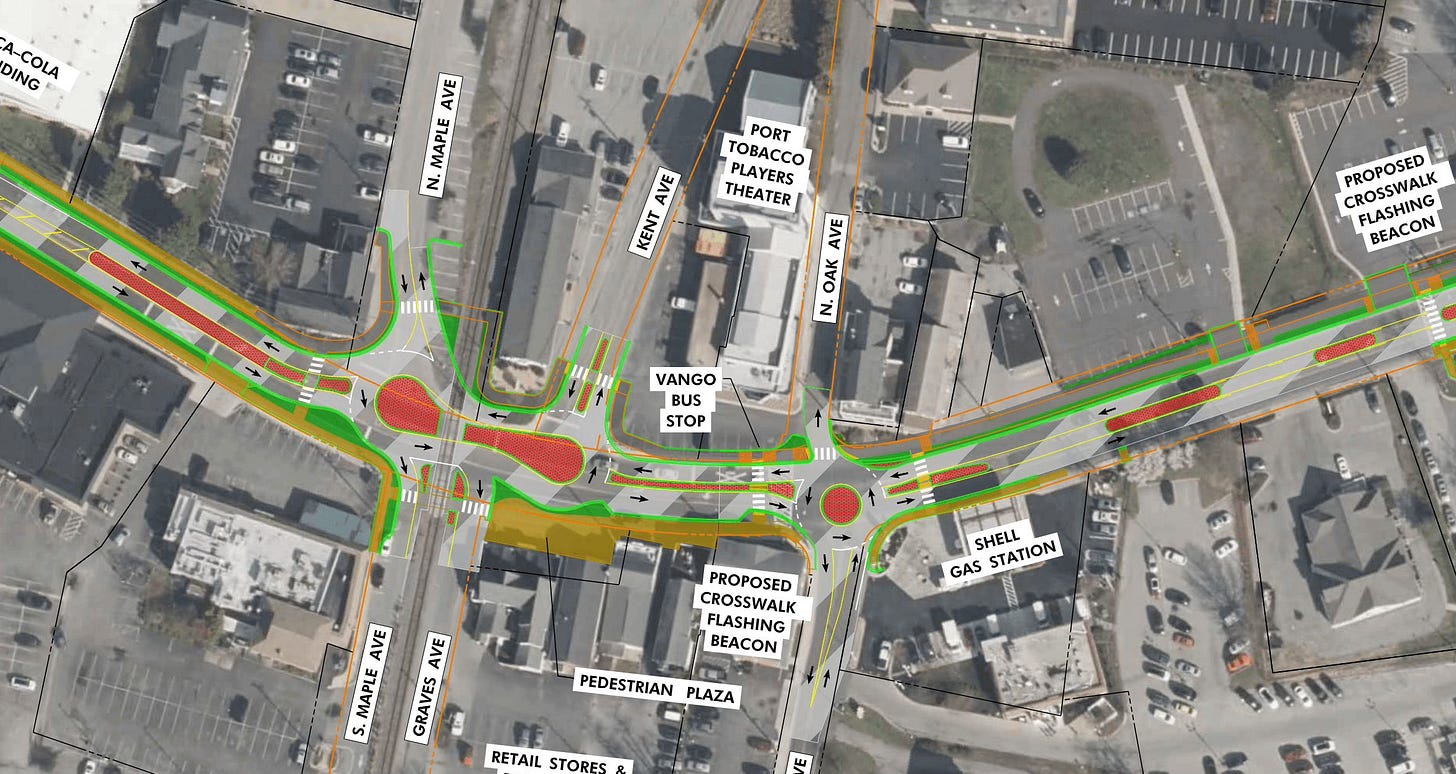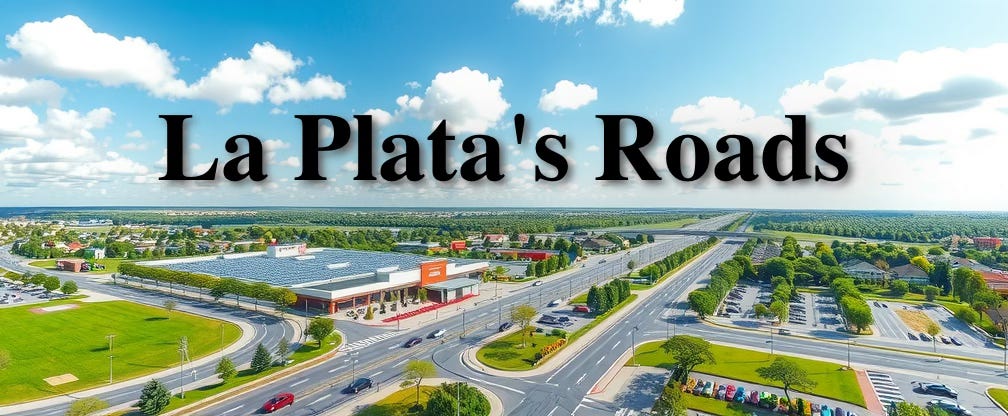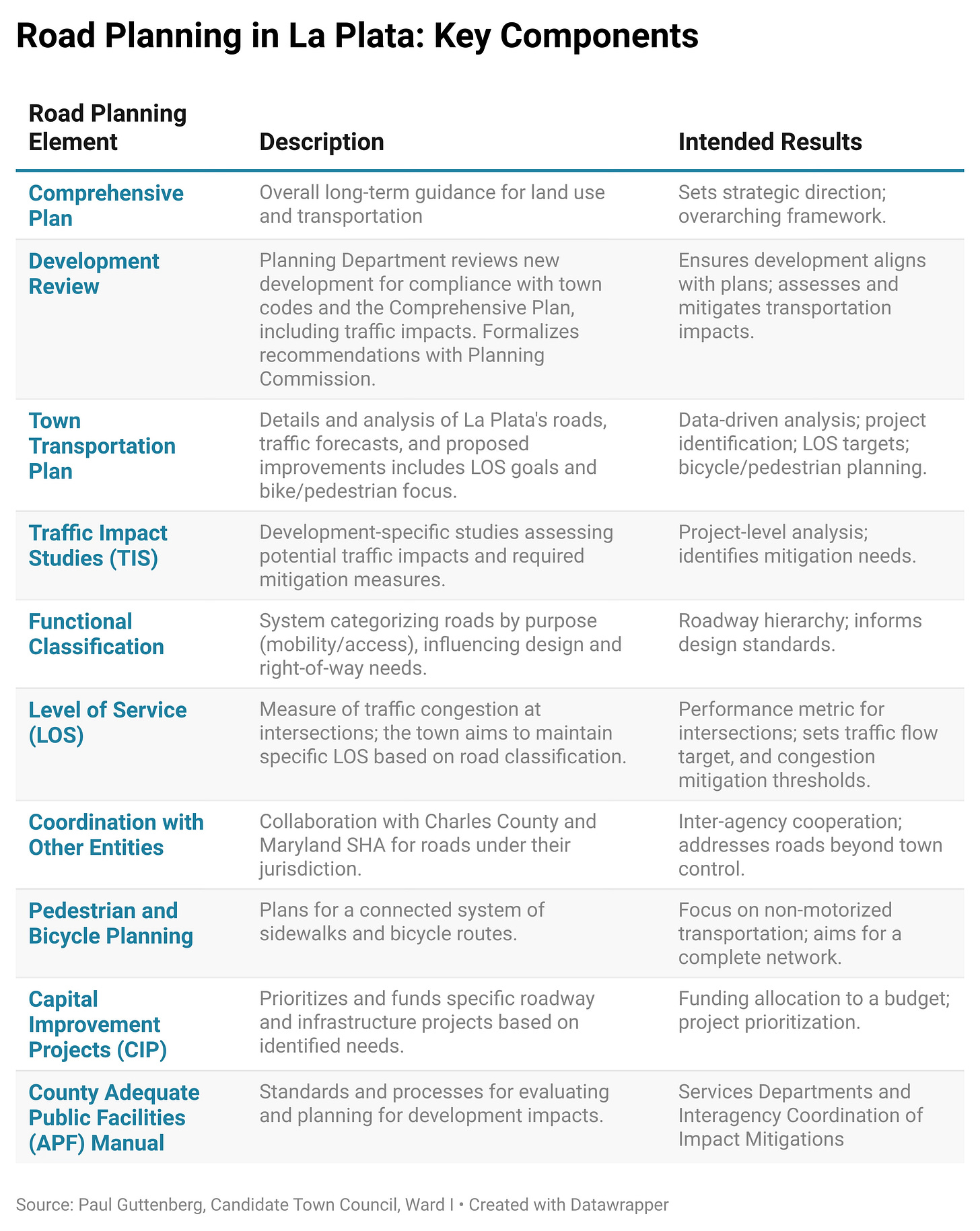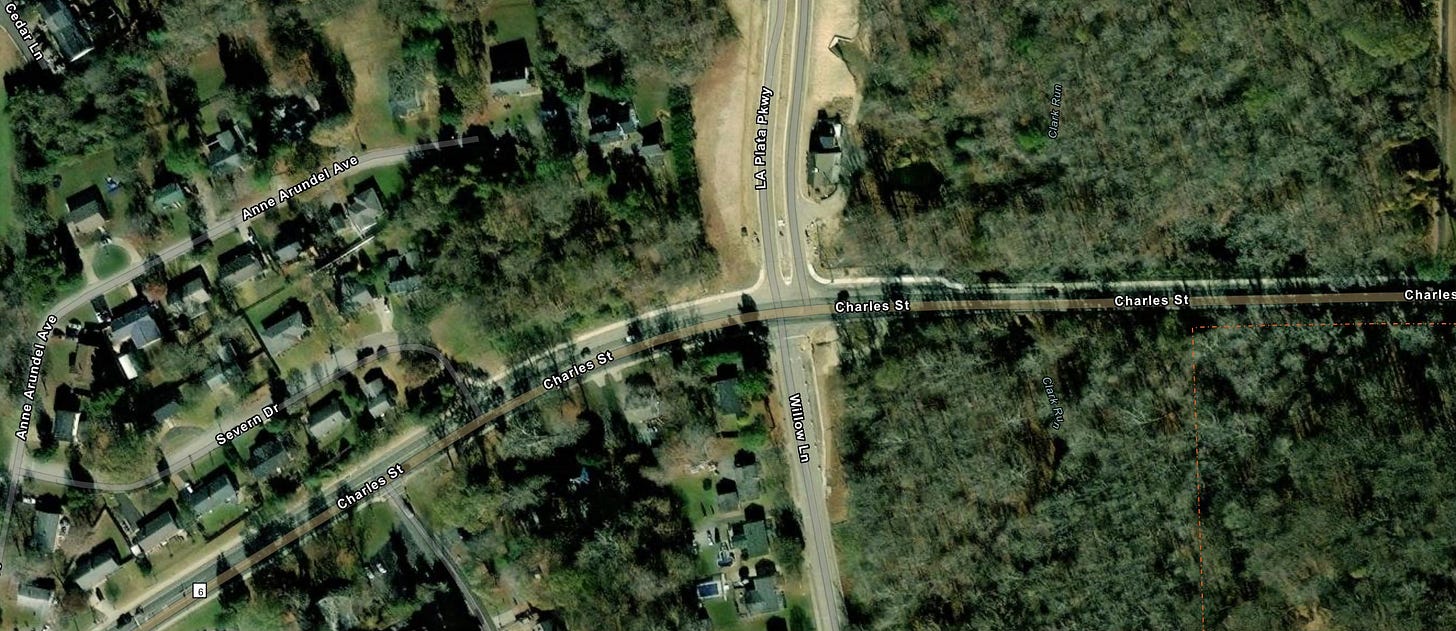La Plata's Roads: Planning for the Future, But Falling Behind?
By: Paul Guttenberg, Candidate for Town Council Ward I
La Plata is experiencing worsening traffic congestion and safety issues that require improved management, despite ongoing planning efforts. Many residents are concerned about traffic on roads like Crain Highway (Route 301) and pedestrian safety along Charles Street.
This article examines La Plata's road planning process and offers recommendations for improvement, contributing to an important discussion in the lead-up to the town’s May 6th General Election.
It's important to recognize that everyone's viewpoint on La Plata’s traffic is shaped by their experiences; perspective is paramount.
Consider these examples:
Long-Term Residents:
Those who have lived and worked in Southern Maryland for most of their lives have observed a significant worsening of La Plata’s traffic.
Newer Residents:
Conversely, I recently spoke to a person who moved to La Plata within the last five years who cited lower traffic congestion in La Plata compared to their previous home as a key reason for their move.
Commuters to Major Metro Areas:
My own experience, having commuted from Charles County to Northern Virginia and Washington D.C. for 27 years, leads me to appreciate La Plata's relatively lighter traffic, even though I see it has increased over the years.
Residents Near New Developments:
People living in established neighborhoods near new developments often feel that efforts to lessen traffic impact should have come sooner, as those efforts often lag behind the increased traffic caused by the development.
While all of these perspectives vary, the need for improved road planning in La Plata is clear.
To understand how the town is currently approaching this issue, let's examine La Plata's road planning process.
How La Plata Plan’s for Roads
The Town of La Plata Planning Department and the Planning Commission employ various methods for road planning, balancing immediate needs with long-term goals.
La Plata’s Road Planning Approach Overview:
Review of development-specific traffic information.
Use of the town’s Comprehensive Plan to guide strategic road planning.
Coordinating with county and state agencies and utilizing relevant regulations.
Identifying grants and recommending funding tools, such as developer impact fees, to offset the town’s costs for mitigating development impacts.
To illustrate the key elements of La Plata's road planning process, the following table outlines the 'what' and 'why' of the strategies and tools used by the town's planners.
Examples of Road Improvement Initiatives
To see how these planning elements are applied in practice, let's examine three specific road improvement initiatives in La Plata. Our town’s planners in coordination with county and state planners use the elements described above to mitigate traffic congestion.
There's a wealth of information available in town meeting videos, planning documents, study summaries, and ordinances related to planning for La Plata’s roads. These examples were selected because they represent a range of planning challenges and outcomes, and because I have personally observed their impact on La Plata's traffic over many years.
1. Mitigation of Traffic Impacts from the Pine Grove Development:
The Pine Grove development illustrates the challenges of interagency coordination (state and county) and funding for new traffic signals, specifically at the intersection of Charles Street (Route 6), La Plata Parkway, and Willow Lane.
This intersection exemplifies a situation where traffic mitigation has lagged behind development. The intersection was already problematic to navigate before the construction of La Plata Parkway and new homes being lived in within Pinegrove . Drivers familiar with visiting the schools or neighborhoods on Willow Lane know well how turning left here onto Route 6 at certain times of day can be perilous. A timelier planning process could have installed improved traffic controls at this intersection concurrent with the start of residents moving into homes within Pinegrove.
Discussions have also taken place in Planning Commission meetings regarding the feasibility of extending Heritage Green Parkway across the rail line to provide additional access to Pinegrove, a complex planning issue due to railroad right-of-way regulations. There is no active plan to add this additional access point.
2. Charles Street Upgrades (East of Route 301):
While the Pinegrove development highlights the challenges of coordinating new development road projects, the Charles Street upgrades address the need to improve existing road infrastructure.
Design work is underway to upgrade Charles Street from Route 301 to Willow Lane, including right-of-way enhancements, potential sidewalk installation, and other safety measures.
This project aims to enhance safety and traffic flow on this key La Plata throughfare. This example illustrates the complexity of coordinating planning across multiple agencies (town, county, and state), reaching agreement on final designs, and initiating construction, a process that can span five or more years for a project of this scale.
The Charles Street Upgrades project is in the design and site preparation phase, a collaborative effort involving the town, county planners, the Maryland Department of the Environment (MDE), the Maryland State Highway Administration (SHA), and the Maryland Department of Transportation (MDOT).
Coordination among these agencies has been ongoing since the project's funding grant was awarded in 2022 and includes recent coordination with the Charles County Fire Department and 911 addressing for technical review and approval.

Construction for the Charles Street Upgrade project is currently estimated to begin in 2027.
3. Upgraded intersection traffic control signal at La Plata Road (Route 488) and Radio Station Road:
This road improvement project was driven by a mixture of existing road infrastructure safety concerns and increased usage because of growth both in the town and our county.
The intersection of La Plata Road (Route 488) and Radio Station Road, a “Y” intersection, is an example of a completed traffic and safety mitigation project. The new traffic signal, installed in 2024, manages traffic to and from Route 6 to several existing residential areas (Agricopia & Kings Grant) and newer sections of residential development (Pinegrove) towards Radio Station Road, where multiple schools, county government buildings, and public parks are located.

People in the Process of Road Planning
Before delving into the shortcomings of the road planning process, it's important to acknowledge the dedicated individuals in La Plata's Planning Department and Planning Commission who work daily on these complex issues. These are our neighbors who live and work here, and they are committed to developing the best possible solutions with the resources we have.
It's important to note, however, that the Town of La Plata has been operating with a prolonged vacancy in the Senior Planner position. This prolonged vacancy has likely hindered the department's ability to implement necessary process improvements and achieve long-term planning goals, highlighting the importance of adequate staffing for effective planning.
In my experience, shortcomings in meeting expectations are more often attributable to flaws within the process itself, rather than the actions of an individual contributor.
A Local Adequate Public Facilities (APF) Ordinance: An Opportunity Unrealized
One significant opportunity for improvement lies in the potential for La Plata to develop its own Adequate Public Facilities (APF) Ordinance, which could address the limitations of the current county-level approach used for La Plata.
Background: The Town of La Plata Planning Department currently uses the Charles County Adequate Public Facilities (APF) Manual as a key component of its planning process. The County APF manual provides rules intended to ensure that essential public facilities, including roads, can support new development. However, the La Plata Planning Commission has explored the possibility of drafting its own APF Ordinance, beginning in January 2023.
During open meetings, La Plata’s planners have expressed concerns that Charles County's existing rules for managing development impacts through the County APF Manual are not ideal for La Plata.
The development of a local APF ordinance is crucial because it would allow La Plata to address, potential loopholes for developers who present multi-phase plans, unclear mitigation requirements, inadequate traffic analysis for local streets, and insufficient local controls. These issues are outlined further below:
Potential Loopholes for Phased Development:
The County's APF Manual rules regarding phased development may allow developers to avoid triggering comprehensive traffic studies.
By developing projects in smaller phases, developers can potentially avoid or delay requirements for significant infrastructure improvements, even if the cumulative impact of the development is substantial.
La Plata planners have discussed including stricter rules in a local APF Ordinance to address this issue.
Unclear Mitigation Requirements:
The standards in Charles County for developer actions to address traffic problems may be unclear and subject to interpretation.
Inadequate Traffic Analysis for Local Streets:
Charles County’s traffic analysis methods, such as "Critical Lane Volume," are primarily designed for major roads like Route 301.
La Plata is concerned with traffic on its local streets and congestion at local intersections, requiring more suitable local street analysis standards.
Insufficient Local Control:
A local APF Ordinance would provide La Plata with greater control over standardized road impact measures and developer mitigations, ensuring that required improvements effectively benefit the town.
Unfortunately, the development of a draft APF Ordinance for La Plata has not been completed, due in part to resource constraints within the town’s planning department, including a long term Senior Planner vacancy.
To capitalize on the opportunity to improve local standards, filling the Senior Planner position and prioritizing the drafting of a local APF Ordinance by the Town Council are necessary. Enacting such an ordinance would enable La Plata to standardize improved local assessments and planning practices tailored to the town and potentially setting a best practice example within Charles County.
Reasonable Resident Expectations For Road Planning
Given the challenges and complexities outlined here in La Plata's road planning process, particularly the limitations of the County APF Manual and the impact of the Senior Planner vacancy, it's important to define what residents can reasonably expect from their town's planning efforts.
1. Clear and Responsive Planning Processes:
Clear Communication of Planning Processes for Residents:
Residents should expect that the town will actively communicate the intricacies of its planning processes in a way that is accessible and understandable to the general public, not just to engineers and developers. This includes clear explanations of how decisions are made, the factors considered, and the timelines involved.
Regular Road Project Summaries:
Residents should receive regular updates on the progress and outcomes of road planning initiatives. These summaries should provide clear, concise information about planned improvements, timelines, and the rationale behind decisions, ensuring residents are informed about how their tax dollars are being used and how their concerns are being addressed.
Opportunities for Meaningful Feedback:
Residents should have accessible and effective channels to provide feedback on proposed developments and road projects at stages where their input can genuinely influence decisions. This includes well-publicized public comment periods, easy-to-use online platforms, and responsive communication from town officials.
2. Timely Road Infrastructure Improvements:
Clear Town Priorities:
Residents should expect the town to establish and communicate clear priorities for road infrastructure improvements. This includes a publicly available list of planned projects, their timelines, and the criteria used to prioritize them. This ensures the town's efforts are aligned with resident needs and progress is measurable.
Process Improvements:
Residents should expect the town to continuously improve its infrastructure development processes to keep pace with growth and address existing challenges. This includes streamlining interagency coordination, expediting project timelines, and adopting best practices for traffic management and safety.
While some road planning issues are beyond the town's control, La Plata must strive to be the best possible partner with external agencies to effectively compete for prioritization of La Plata’s projects at the county and state level.
Why Road Planning Often Falls Short of Expectations: Addressing Systemic Challenges
Despite the best intentions of La Plata's dedicated planning staff, as acknowledged earlier, the town's road planning efforts often fall short of residents' expectations. This gap between planning and perception stems from systemic challenges that require attention and action.
Local Accountability:
A primary reason for the shortfall is the town's reliance on the Charles County Adequate Public Facilities (APF) Manual. While this manual provides a baseline, it doesn't always address La Plata's specific needs, particularly concerning local street traffic and the cumulative impact of phased developments.
The Town Council possesses the authority to implement stricter road requirements and demand more thorough traffic studies than those mandated by the county APF Manual. However, without a strong commitment to local accountability, these discretionary powers are underutilized.
Residents expect their elected officials to prioritize local needs and ensure that development impacts are adequately mitigated, even if it means exceeding county standards.
Senior Planner Expertise:
The prolonged vacancy in the Senior Planner position creates a significant obstacle to effective road planning. This role is crucial for implementing process improvements, conducting thorough impact assessments, and coordinating with external agencies.
Without the expertise and continuity that a Senior Planner provides, the town struggles to address complex planning issues, such as the development of a local APF Ordinance or the efficient management of projects like the Charles Street upgrades.
Residents expect the town to have the necessary expertise and resources to develop and implement effective road improvement plans.
A Call to Action for the Next Town Council: Leadership for Clear and Responsive Planning
To meet resident expectations, and to address the systemic challenges outlined earlier, the next Town Council must adopt a proactive and transparent approach to road planning. Here are key actions they should prioritize:
Prioritize Completion of a Draft La Plata Adequate Public Facilities Ordinance (APFO):
As discussed La Plata's reliance on the Charles County APF Manual has limitations. A locally tailored APFO would allow the town to address specific concerns like phased development loopholes and inadequate local street traffic analysis.
This ordinance would provide a standardized framework for evaluating development impacts and determining necessary improvements, ensuring that growth tailored to La Plata’s town infrastructure scale.
Develop a Public List of Road Assessment Priorities:
Creating a prioritized list of planned road projects or assessments, even those not yet funded in the Capital Improvement Plan (CIP), would enhance transparency and accountability.
This list would provide residents with insight into the town's long-term vision for road improvements and allow them to provide feedback on project priorities.
This also allows the Town Council to provide clear direction on priorities to the Planning Department and Planning Commission.
More Aggressively Seek Impact Fees for Road Projects:
Given the financial constraints and the need to mitigate the impacts of new development, the town should more aggressively seek impact fees from developers.
Specifically, the town should seek to collect additional funds through large scale view (larger planned sections and phase assessment) from new development specifically for addressing local road needs created by that development.
This would ensure that developers contribute their fair share to infrastructure improvements, reducing the burden on existing residents.
Share Planning Process Information Openly:
The town should create public-friendly summaries of planning data, making it easier for residents to understand complex technical information.
While detailed planning data should remain accessible, providing concise summaries would enhance public engagement and ensure that residents are well-informed.
Actively Invite Residents for Planning Comment:
Meaningful feedback requires active engagement. The town should establish regular public comment periods and actively solicit feedback through various channels (email, social media, phone, public meetings, etc.).
Making it exceptionally easy for residents to ask questions and ensuring timely responses would build trust and foster collaboration. Responses by planning leaders, Town Council members or through Frequently Asked Questions (FAQ) pages.
Pursue Regional Collaboration Opportunities:
Many road planning challenges extend beyond La Plata's boundaries. The town should actively investigate successful regional approaches to inter-jurisdictional cooperation.
Communicating road connectivity and intersection impacts that affect La Plata but lie outside its boundaries, such as the Route 301 Harry Nice Bridge widening and the Route 301 and Washington Ave. intersection, are important to addressing local road issues.
Update the Transportation Plan:
The town’s transportation plan was last updated in 2009. Prioritizing updating the town's Transportation Plan, and establishing a schedule for future updates is a necessity.
This plan is a guiding document that helps shape the future of the town’s roadways, and needs to be up to date to reflect the current and future needs of the town.
If elected as your Town Council member for Ward I, I will work with the rest of the council to advocate for these items to reach the goal to achieve clear and responsive road planning for La Plata.
A “Vote Local” Plan For Town Council & Mayor
Plan To Vote: Please Verify Your Voter Registration Status. If needed please update your voter registration before 7 April.
Share Election Information: Please Share Election Information with Your Family, Friends & Neighbors Who Live In the Town of La Plata. www.voteguttenberg.org/vote-local/
Cast Your Ballot On Tuesday, May 6th 2025. Voting occurs in person at the La Plata Town Hall, located at 305 Queen Anne Street.
(Voting hours are 7 am - 8 pm)
Voting hours are 7 am to 8 pm on election day, Tuesday May 6th.
Thank you again and please see my web page for more information about me as your Ward I candidate.
I ask that you consider voting for me as your Town Council representative from Ward I.
More than anything I hope you take the time to vote, and that you encourage others to do the same. When residents vote in larger numbers, it increases the emphasis for elected town leaders to engage and respond to concerns expressed by the public.
Thank you.
Respectfully,
Paul Guttenberg, Candidate for La Plata Town Council Ward I











